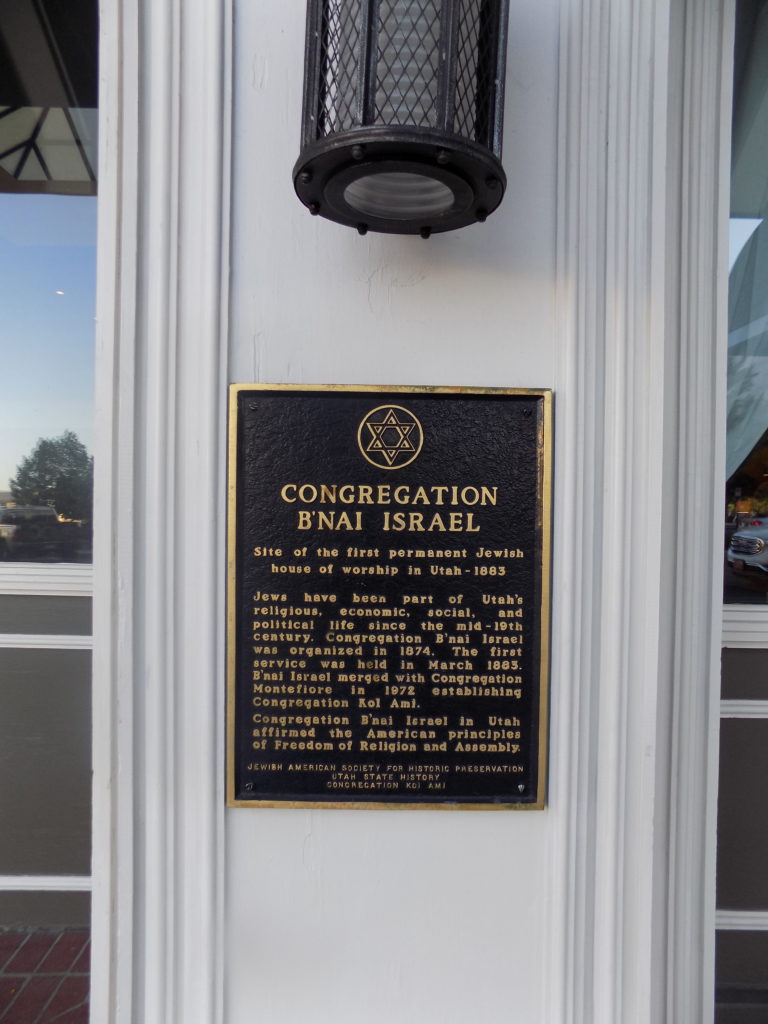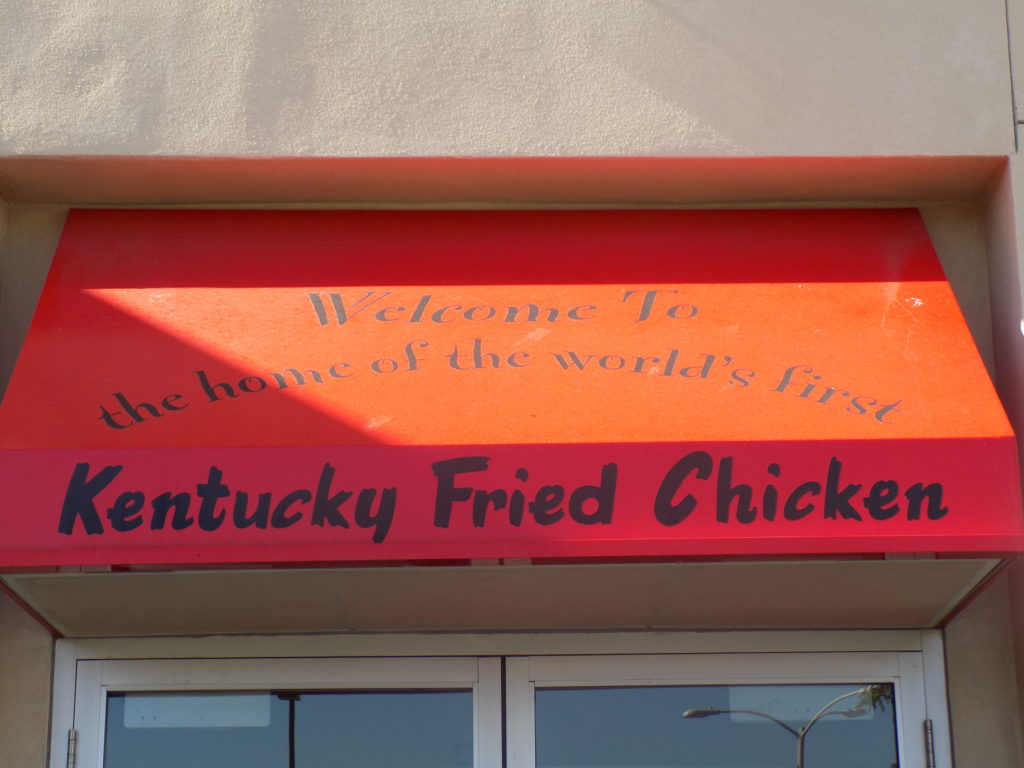Previously, I promised I’d explain why I chose to stay at the Peery Hotel in Salt Lake City. First, when I travel, I try to favor locally owned hotels rather than supporting the large hotel chains. (Some of you might say that I stretched that definition to stay at the Peery which is part of the Ascend Hotel Collection franchise operated by Choice Hotels. I’d describe the Peery as a moderately upscale boutique hotel that fits with the description on the Ascend website that its hotels are “part of the essential fabric of the destination, enabling guests to experience the local destination like a native.”) The Peery opened in 1910 and has been operating continuously at the same site since then so my thought was that getting support from a chain like Choice might have simply been a necessary step to assure the hotel’s survival.
Obviously, the Peery wasn’t the only local option available but the balance tipped in the Peery’s favor when I happened across a photo of a marker on the outside of the hotel.
Although I have said that I view myself as genetically, culturally, and circumcisionally Jewish but, as an atheist, clearly not religiously Jewish, I found the thought of staying on the site of Utah’s “first permanent Jewish house of worship” appealing in a smugly amusing sort of way.
Adventure is out there!
If you’ve been riding with me since I arrived in Tucson or even if you just joined the trip with the preceding entry, you know that I will happily take small detours just to take a photo of some curiosity that piques my interest and, if it has something to do with a movie, all the better. That’s exactly how I started my morning aiming my car 20 miles south to the sprawling suburb of Herriman on Salt Lake City’s west side.
A local Utah home building company, Bangerter Homes, has this slogan on their website:
If you dream it, we can custom design & build it for your life.
A bit less than 10 years ago, in what I guess was an exceptionally clever marketing strategy to prove the slogan true, the company approached the Walt Disney Company for permission to replicate a house from one of Disney’s recent animated films. Disney granted that permission. However, while the exterior was well known, Disney had no other plans they could share so the brothers had to base their interior designs from the few rooms that actually appear in the movie. They completed the house in 2011 and offered it for sale for an initial price of $399,000. I have no information on the sale date or price but I can tell you that it’s currently occupied by the Hamblins.
The Utah sun has faded the exterior over the years but the house from
UP! should be immediately recognizable to those who have seen the movie. In this folder, you can see more pictures of the house including a side by side view (that I lifted off Atlas Obscura) and you can learn how I discovered the name of the family that lives there.
The birthplace of Kentucky Fried Chicken.
Had it not been for the Interstate Highway System and a Utah restaurant owner named Pete Harman, the world might not have Kentucky Fried Chicken. Well, maybe it would but it might not be as ubiquitous and would almost certainly not be known by that name. Here’s the story:
In 1930, a fellow named Harland Sanders took over a Shell filling station on US Route 25 just outside North Corbin, Kentucky where, with only a single table, he began serving meals to travelers based on recipes for steak, country ham and, of course, fried chicken that he’d learned as a child. Four years later he bought a larger gas station on the other side of the road and expanded his restaurant space to six tables. After being given the honorary title of Kentucky Colonel in 1936 (which he carried proudly and ostentatiously until the end of his life), Sanders purchased the motel across the street continuing the expansion of his restaurant in the process and naming it the Sanders Court & Café. (It’s now a museum in North Corbin.)
Sanders long refused to deep fry his chicken because he believed it lowered the quality. His insistence on pan frying, however, meant long waits for his customers who ordered fried chicken. In 1939, he bought one of the first commercial pressure cookers, modified it into a pressure fryer and was pleased with the result. It took him until 1940 to finalize his secret recipe of 11 herbs and spices.
A year after Sanders met Salt Lake City restaurateur Pete Harman at a restaurant convention in 1951 in Chicago, he signed the first franchise deal for his chicken recipe. And it was in Salt Lake City that Kentucky Fried Chicken was born. You see, Harman wanted to create a sense of something exotic – or at least exotic for Utah – around his chicken. A fellow named Don Anderson, who worked for Harman, is said to have christened the Colonel’s recipe Kentucky Fried Chicken.
Harman’s success got Sanders thinking about more franchising opportunities but his real effort at using that model to build the KFC brand didn’t begin until about 1955 when the planned route for Interstate 75 bypassed Corbin. Sanders saw a potentially bleak fate awaiting the Sanders Court & Café. Working in tandem, Sanders and Harman developed an initial franchising plan where they licensed the recipe to restaurant owners for a fee of four cents per chicken.
By that time Harman had already put additional familiar marketing tools in place. He had coined the phrase “It’s finger lickin’ good.” He also introduced the “bucket meal” (which originally was 14 pieces of chicken, five bread rolls and a pint of gravy in what became the company’s signature cardboard container) in 1957. By 1963, about 600 Kentucky Fried Chicken franchises spiced the U S restaurant landscape.
Harman’s original building was razed in 2004 so, while a KFC exists on the site, any part of the building visible in the photo is not part of the original. This is where you can see photos of the statue of Sanders and Harman as well as an odd sign that doesn’t appear to be original either (though it could be from the fifties or sixties) if the black and white photo I took from someone’s Pinterest page is accurate.
Note: In keeping with my 2022-2023 reformation of the blog into shorter entries, backdated to maintain their sequence, any comments on this post might pertain to its new configuration. See the full explanation in the post Conventions and Conversions.



A two-headed lamb?? Eew- or should I say Ewe?.
Seems like the museum’s scope of collections was rather broad.
Definitely ewe.